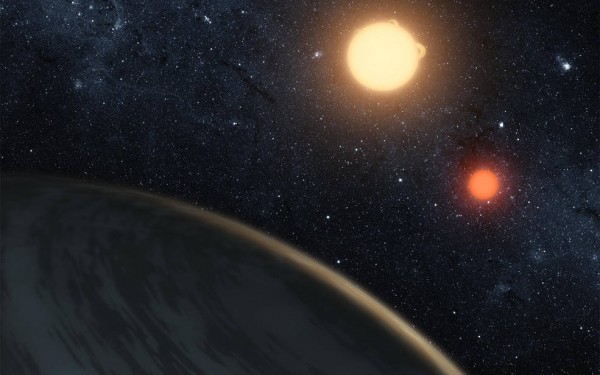By Ana Verayo, | December 20, 2016

The gas giant Kepler-16b, nicknamed 'Tatooine,' orbits a pair of stars. One star is a small red dwarf star, the other is a larger K dwarf. (NASA/JPL-Caltech)
Thousands of exoplanets have been detected outside our solar system. Some of them might even remind you of the fictional worlds in the "Star Wars" films, from icy worlds to arid, desert planets. In fact, NASA says that these fictional planets do exist.
Like Us on Facebook
With the help of NASA's Kepler Space Telescope, astronomers have discovered more alien planets similar to those in Star Wars, such as the Kepler-16b, which is the size of Saturn, located some 200 light years away from Earth. Kepler-16b is almost similar to the planet Tatooine where Luke Skywalker was born.
NASA officials revealed that our solar system is apparently unique due to our single sun, as most star systems in the Milky Way galaxy possess two stars instead of one. Kepler-16b might be a real-life Tatooine, but the conditions are too cold or gaseous for life to thrive, but another Tatooine twin might exist elsewhere in the universe.
According to astrobiologist Shawn Domagal-Goldman of NASA's Goddard Space Flight Center, the desert worlds in Star Wars films are interesting since current studies and research show that these worlds could exist in the galaxy.
More interestingly so, the lack of water can make real-life desert worlds more habitable since the excessive presence of water in an exoplanet can make it either too hot or too cold, similar to Venus or Jupiter's moon Europa.
Jupiter's icy moon can closely resemble that planet Hoth, where the Rebel Alliance's base was located during the "Star Wars Episode V: The Empire Strikes Back." In real-life research, Europa's icy surface hides a global ocean of liquid water that can potentially host life. NASA is planning a mission to the icy moon to explore this mysterious, icy ocean.
However, ocean worlds such as Scarif in "Rogue One" and Kamino in "Star Wars Episode II: Attack of the Clones" are still yet to be confirmed. NASA officials say that these aquatic worlds can exist, and can be detected in the not so distant future due to its reflective brightness from these worlds' global oceans.
Scientists and astronomers are excited about the potential discovery of more alien worlds with the help of new technology such as the Hubble's successor, the James Webb Space Telescope and the Transiting Exoplanet Survey Satellite (TESS) which can detect the atmospheric conditions and compositions of distant exoplanets. Apart from these, the Wide Field Infrared Survey Telescope (WFIRST) will be launched in the 2020s that can also capture images of exoplanets orbiting solar twins.
-
Use of Coronavirus Pandemic Drones Raises Privacy Concerns: Drones Spread Fear, Local Officials Say

-
Coronavirus Hampers The Delivery Of Lockheed Martin F-35 Stealth Fighters For 2020

-
Instagram Speeds Up Plans to Add Account Memorialization Feature Due to COVID-19 Deaths

-
NASA: Perseverance Plans to Bring 'Mars Rock' to Earth in 2031

-
600 Dead And 3,000 In The Hospital as Iranians Believed Drinking High-Concentrations of Alcohol Can Cure The Coronavirus

-
600 Dead And 3,000 In The Hospital as Iranians Believed Drinking High-Concentrations of Alcohol Can Cure The Coronavirus

-
COVID-19: Doctors, Nurses Use Virtual Reality to Learn New Skills in Treating Coronavirus Patients







